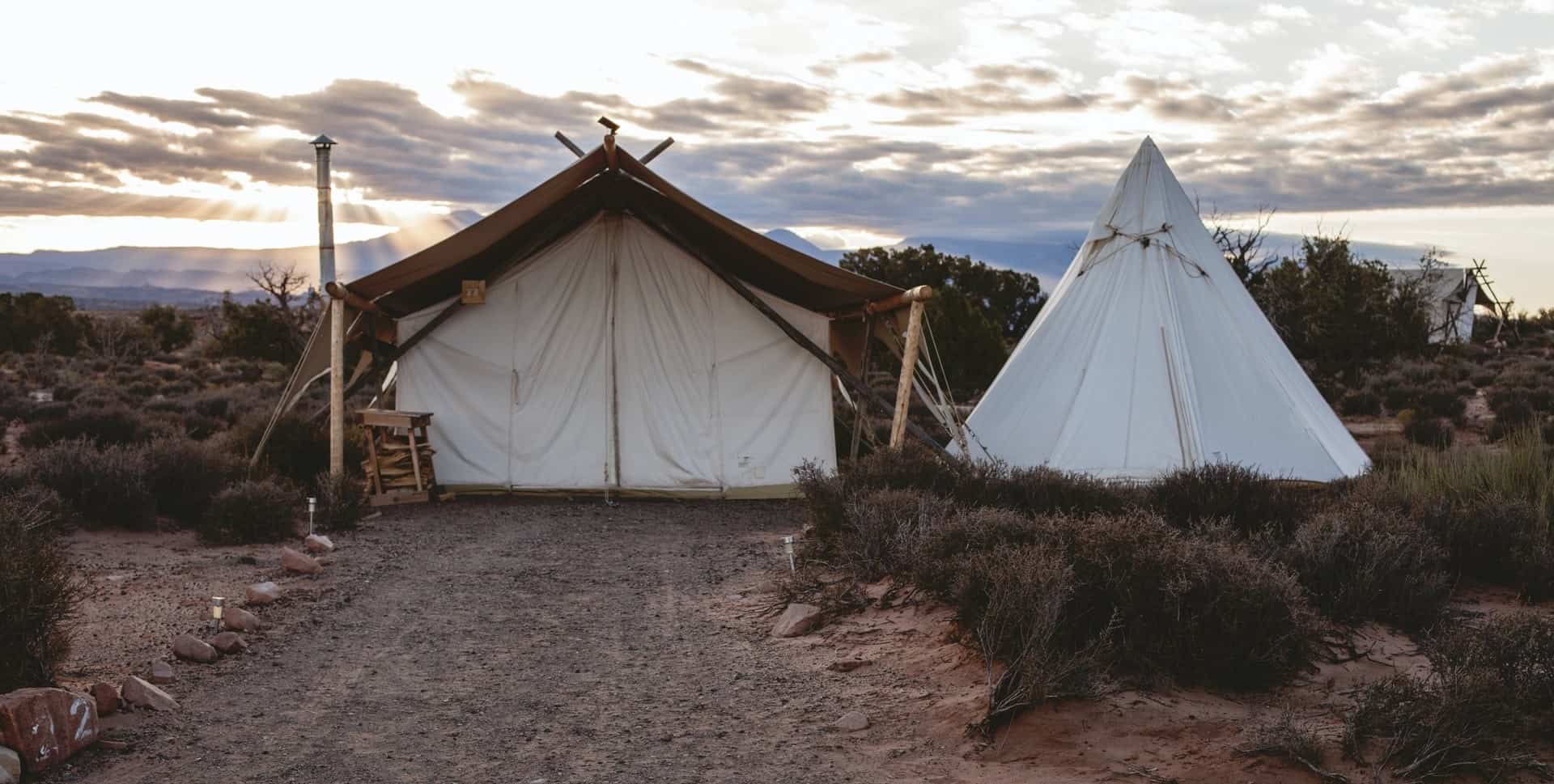Many a camper has toyed with the idea of abandoning the status quo to camp full time. Whether traveling cross country, trying to save money, or exploring alternative ways to live, if you want to make your adventure successful, you must know how to live in a tent long term.
Here are the steps to living in a tent long term:
- Find the right tent for you
- Choose your location
- You need a water supply
- Educate yourself on the local wildlife
- Be prepared for emergencies
- Insulate your tent
- How will you store food?
- Prepare food in your tent
- And more …
1. Find The Right Tent For You
If you are serious about living in a tent long term, it is worth spending time and money to find the perfect tent.
A good tent will be the one thing that can make or break your adventure. After all, your tent will be your home. Investing in a proper, high-quality, 4-season tent that is strong enough to withstand the elements and spacious enough to live comfortably is crucial.
The size and weight of your tent will depend on how often you will be moving around and whether or not you are camping alone or with a partner. While you can technically live in a small backpacking tent, you won’t be able to do it for very long. A canvas tent is a better option for long-term tent living.
Here are a few things to consider in a tent:
- waterproof and weather-resistant fabric
- total weight
- additional features such as a stove jack
- height; are you able to stand in it?
- ventilation; for camping in hotter climates
- comfort level and space
For couples, the Whiteduck Avalon Canvas Bell Tent is spacious and luxurious. It is made from an extra-strong and durable army duck cotton canvas. But it is heavy so you won’t be able to move it about without a car. One drawback of this tent is that it takes longer to warm due to its size.
There are many great tents for individuals or couples, and knowing what you are willing to compromise on and the amount of space you need will be beneficial. Luckily, we have written an article that compares the best tents to live in full-time, which will make your search easier.
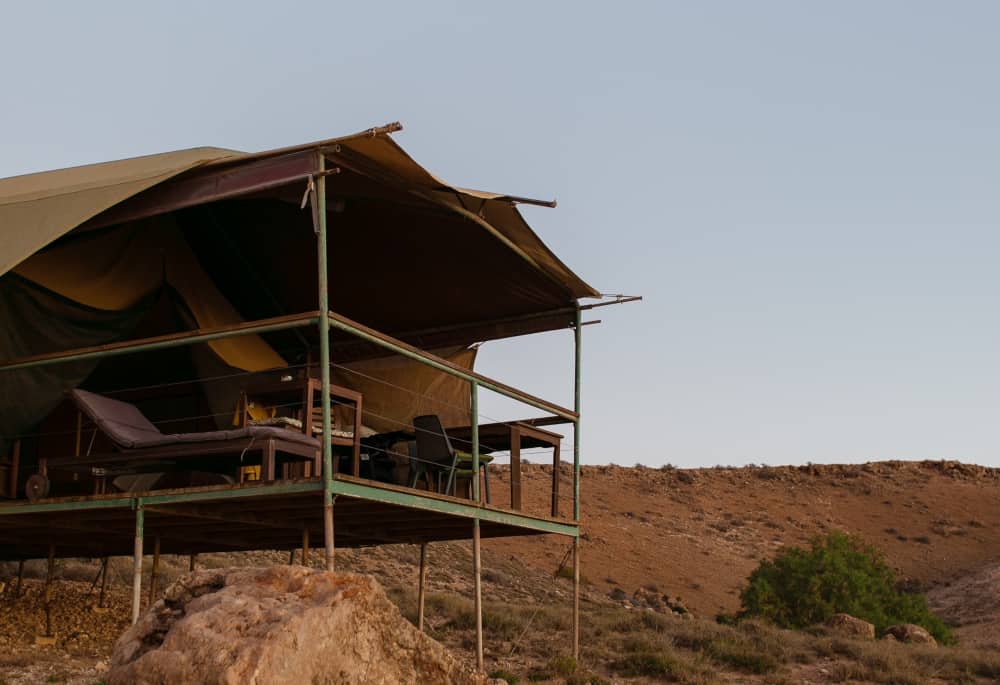
2. Choose Your Location
Before heading on your great adventure, you must know where to pitch your tent. Will you stay on a farm, in the back yards of friends and family, on campgrounds? One of the greatest perks of choosing to live in a tent is that you get to decide where you want to stay and for how long.
Asking yourself these questions will guide the rest of your planning. Your location will play a big role in your cooking and cleaning habits, what you have access to (wifi, showers) and how often you need to move. There are several options for locations, all with their advantages and disadvantages.
What makes a location great for camping?
- access to fresh water
- safety
- accessibility; you can park close to your tent
- sheltered from the elements
Campgrounds provide the benefit of amenities such as showers, bathrooms, and electricity. Some campgrounds allow long-term stays while others only allow you to stay for three weeks at a time. Phone ahead to check what their stance is on long-term tent camping.
National parks are another option, but like campgrounds, the rules vary from park to park. Many national parks require a permit for camping, and they usually have a maximum length of stay. On the plus side, many have washing facilities and electricity points.
While campgrounds and national parks are not usually free, many will allow you to pitch your tent and stay for free in exchange for volunteer work in the form of maintenance, labor, or hosting. Many of the positions require a commitment of two months or more, perfect for slow travel.
Off-grid communities and eco-villages are also wonderful places to stay for a few months or longer. The best way to find these communities is through Facebook and social media.
If you are trying to save money, free camping will appeal more. You will be spoiled for choice by the many places where it is legal to camp for free. When free-camping, it is important to live by the “leave no trace” principle and protect nature for other campers who follow you.
Here are a few valuable resources to find free campsites across USA and Canada:
Lastly, you can ask friends or family if you can stay in their backyards. This is a terrific option if you want to save money but need to be close to town for work. You can also ask private property owners or farmers to stay on their land in exchange for a small fee or contribution.
3. You Need A Water Supply
Wherever you choose to live, you will need access to water. Not only do you need fresh drink water, but you also need water to wash, cook, and clean your dishes.
When you are not staying at a campground with fresh water, look for a water source like a stream or river to camp close to. Keep in mind that camping too close to a river during the rainy season will put you at risk for floods.
You can collect rainwater using a tarp and a bucket if no streams or wells are nearby. Set up the tarp so that all the water runs to one point, and make a hole so that the water runs into the bucket. Alternatively, you can fill 25l water containers at a local water point if you have transport.
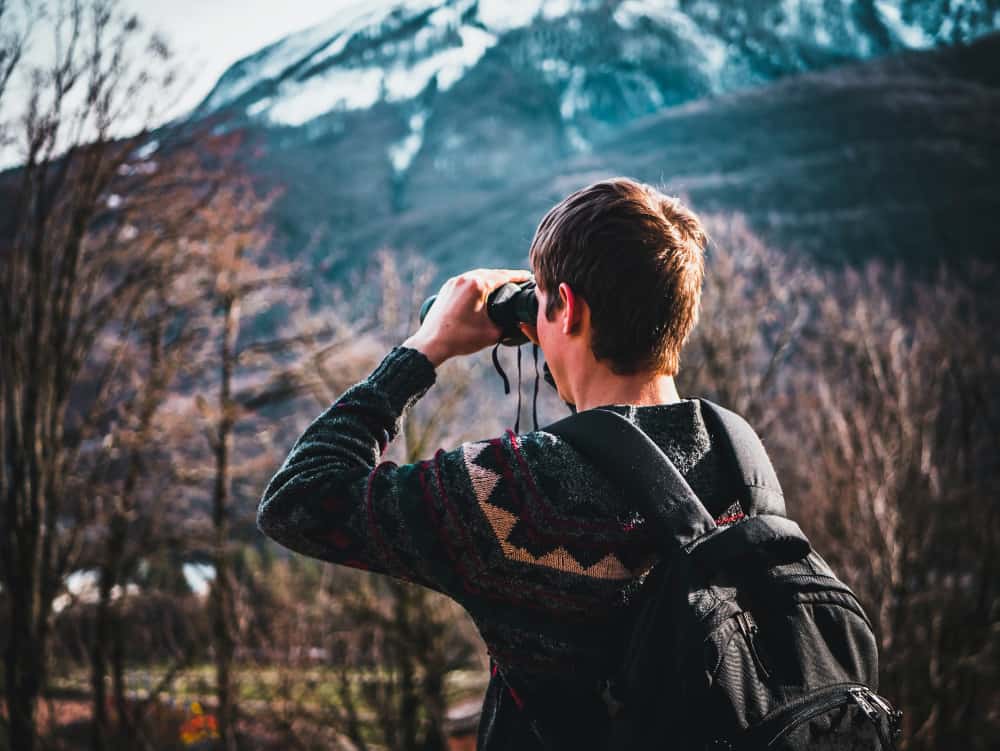
4. Educate Yourself On The Local Wildlife
While living in the wilderness can be a soul-enriching experience, getting bitten by a snake or attacked by a bear is not. Studying the local wildlife and how to protect yourself from possible attacks or bites is important.
Although attacks from bigger predators like bears are unlikely at campgrounds and private properties, snakes and spider bites are still a possible threat. Mosquitos are not exactly “wildlife” but can be annoying or carry diseases depending on where you live. A mosquito net and some insect repellent will protect you against mosquito bites.
5. Be Prepared For Emergencies
Any camper knows how vital a first aid kit is for emergencies. Always make sure you have a well-stocked first aid, and be sure to include emergency contact numbers for the area you are living in. We have a free printable first-aid checklist for convenience.
Emergency numbers to include:
- General emergencies; 911
- Local police
- Poison emergencies
- Fire Department
- Mountain rescue numbers
- Mental health emergency numbers
- Personal health insurance numbers
- Emergency contact (friends and family)
Other emergency equipment includes a tracking device like a map, compass, or GPS, a space blanket for hypothermia, and a whistle. Always keep your phone charged, and if possible, invest in a satellite phone. Satellite phones are especially handy for remote areas where cell phone networks are weak.
The Garmin InReach Mini is a great satellite phone and also functions as a GPS. The built-in SOS button that sends your location to a search and rescue center makes this device one of the best.
6. Insulate Your Tent
Nights can get chilly, even in summer. After all, you only have a piece of canvas separating you from the outdoors. A wood stove will help warm your tent, but without properly insulating your tent, you will still get very cold!
Adding a ground cover will insulate your tent floor from the cold ground at night. Use rugs, flooring, foam padding, or a tarp to insulate your floor from the inside. Rugs will give your tent a homey feeling as well.
You can place insulation fabric between your tent and the tent cover for very cold climates, keeping windows and ventilation holes open. Placing a thermal blanket over your roof is another way to keep your tent warm.
However, camping in a place sheltered from the wind makes a world of difference. Alternatively, you can use tarps to shield your tent from the wind or build windbreakers around your campsite.
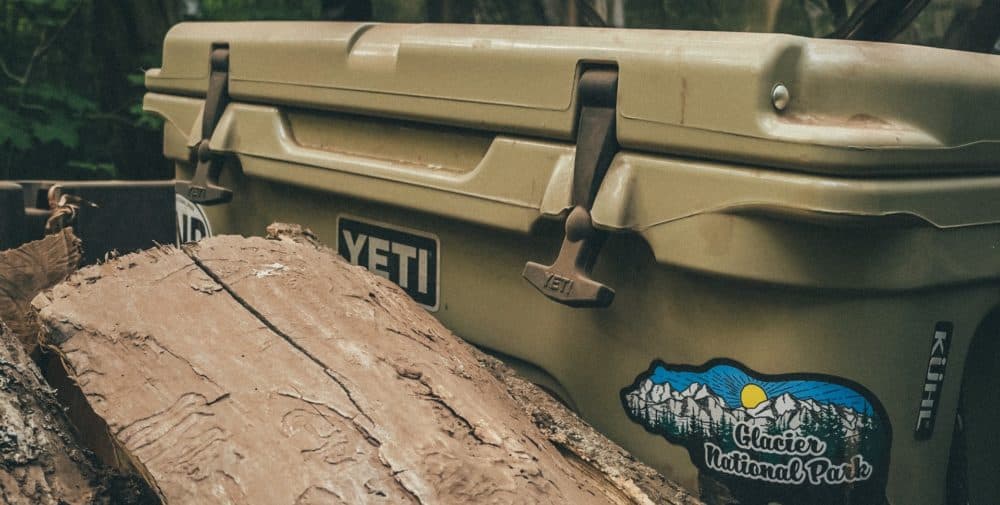
7. How Will You Store Food?
Depending on where you are camping and how long, you might need to get creative with your food storage. The biggest challenges of storing food in a tent are lack of electricity and attack from wildlife like bears.
If you stay long-term on private property or campgrounds with electricity, you can get a mini-fridge and keep a few days’ worth of food.
However, if bears are a threat, you must store your food safely. Never store food in your tent. Bears have an incredible smell and will pick up on the food even if it is in a can. Dry goods like cans, spices, pasta, etc., must be kept in bear-resistant dry boxes, such as the aluminum boxes from Mad Cow Metalworks.
Place anything that is not in a can in glass jars in the dry box. Food can be kept in the trunk of your car with all the windows closed and doors locked. Otherwise, dry boxes must be stored at least 100 feet (preferably more) from your tent.
Fresh goods can be kept in coolers. It is worth investing in a high-quality cooler that is durable and will keep your food cold longer. The Yeti Tundra is an excellent cooler that is dry ice compatible. IGBC-certified coolers like the Kong Cooler are safer for areas with bears.
Like dry boxes, store coolers away from your tent, and only buy food that you will be able to eat before it goes bad. Unfortunately, this means buying fresh goods more often.
8. Preparing Food In Your Tent
Preparing food in the summertime is pretty straightforward. You can make a fire outside and grill your food on the fire or use a camping gas stove. There are many camping stoves to choose from; some use propane and some butane. The biggest difference is their boiling point.
Jetboil stoves use a blend of both gases, giving you the best of both worlds as propane has a lower boiling point and is, therefore, more suited in winter. Check out our article on the best jetboil stoves to choose the perfect one for you.
When using gas stoves to prepare food, always do it outside. Suspend a tarp over the area to shelter you from rain and wind. That said, cooking outside during rain and cold is no fun. A wood-burning stove that you can place inside your tent is a much better option and will also warm your tent.
However, carbon monoxide poisoning is a real danger when burning wood or gas inside a tent, and many inexperienced campers have died this way. Always make sure your tent is well ventilated. Luckily, most high-quality tents with stove jacks have adequate ventilation windows.
Be sure to place a fire-resistant rug under your stove to protect your tent floor from any embers from the stove.
You will also need the usual kitchen essentials, like pots and pans. To save space, be strategic about your kitchen tools and only buy what you use daily or frequently. One or two mugs are more than enough, as you can use disposable mugs for visitors or ask them to bring their own. Use our printable camp kitchen checklist to ensure you are covered for the basics.
Lastly, washing your dishes immediately after eating when living in nature is crucial. No food or food scraps must be left in your tent as it will attract pests, flies, and wildlife. Smaller spaces can look cluttered and dirty quickly; another reason to clean and tidy up as you go.
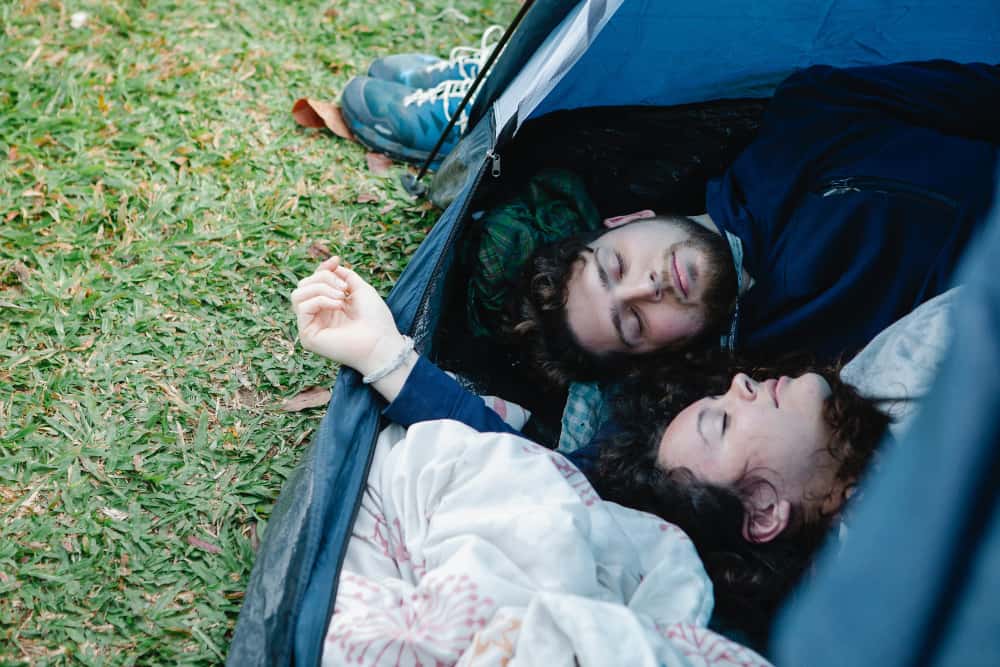
9. Sleeping In A Tent
Sleeping in a tent doesn’t have to be uncomfortable, and you don’t need to sleep on the ground. Sleeping on the ground is not the best long-term idea for sleeping in a tent.
Nothing makes a person crankier than a bad night’s sleep. The mere idea of sleeping uncomfortably is enough to put people off camping. Luckily, there are plenty of options for you to choose from.
Camping Cots
Camping cots are elevated from the ground to insulate you from the cold ground air. Even if you have rugs or a tarp on the floor, elevating your sleeping space keeps you extra warm and comfortable. The Coleman Trailhead Cot is sturdy and affordable. Another great option is this folding cot and mattress combo.
If you are using a camp cot, placing a rug under the cot is best to prevent the feet from pressing into the tent floor. You can also place cardboard between the floor and rug for extra protection.
Use a cot with a sleeping bag or blankets. Placing a sleeping bag on the floor is not a viable long-term solution, so combining a cot and sleeping bag works great!
Air Mattress
You can’t go wrong with an air mattress for a good night’s rest. There is only one drawback; it needs to be inflated. Forget about blowing it up yourself and instead get a good pump. Many air mattresses are sold with the pump included, and it is best to look for one of those.
Pumps can be battery operated, manual (you pump by stepping on it), or hooked up to your car or electricity points. Add lots of blankets or a sleeping bag if you prefer.
Placing your air mattress on a frame is a superb way of insulating your bed while making your tent look homey. You can buy a second-hand frame from Craigslist or Facebook marketplace. Alternatively, you can make a DIY frame with pallets.
We recommend the Coleman Camping Cot, Air Mattress, and Pump Combo for a camping cot and air mattress combination. The cot is foldable and includes a battery-operated pump. Best of all, it also includes two built-in bedside tables.
Camping Bunk Beds
Like a cot, camping bunk beds are elevated from the ground. Most have metal frames and can be used with an air mattress or foldable sleeping pad. The added space is the benefit of using a camping bunk bed instead of a cot.
You can sleep on top or bottom bed and use the other bed for storage. Use it to store your clothes, backpacks, extra blankets, and pillows. Some camping bunk beds have a foldable lower frame that converts into a couch.
Futon Bed
Futon beds are more comfortable than you may think! You can choose between traditional Japanese futon beds or a sleeping couch-style futon bed. Both provide you with additional space during the day.
A traditional Japanese futon bed consists of a futon mattress placed on a hard tatami mattress or rug made from rush grass.
10. Hygiene In A Tent
You don’t need to shower daily to be clean and hygienic. You only need a bucket or jug to wash your face, brush your teeth and clean the essentials. A shower or bath every second day is sufficient.
If you are living on campgrounds, you will likely have access to showers and fresh water. Rivers and streams are suitable places for bathing, but make sure you use environmentally-friendly, biodegradable soaps and toothpaste.
Many campers and vanlifers use solar-heated hanging showers or pop-up shower tents with a hand-powered pump. Dry shampoo comes in handy for days between showers or when it is too cold to bathe in the river.
Local beaches often have free showers but for regular access to hot showers that you can enjoy guilt-free, consider getting a gym membership at a 24hr gym or a nationwide membership if you can. Depending on the gym, you can access showers, swimming pools, saunas, and lounges with free wifi.
When nature calls, you have a few options. While you can go outside, dig a hole, and do your business, this won’t work in winter or when it’s raining. You can use a bucket for the night and unpleasant weather, but a more permanent toilet setup will be much better.
Camper toilets and porta-potties are convenient and easy to use. The Dometic portable toilet is perfect for off-grid living as it flushes with a touch button, so no batteries or pump is needed. It’s extremely popular with digital nomads and vanlifers as it is easy to use, clean, and takes up minimum space.
Another option is a composting toilet. Composting toilets don’t smell when used properly, and waste is easy to dispose of, but they require installation and venting. However, the Cuddy is a new, portable composting toilet available on pre-order.
Placing your toilet outside in a pop-up shower tent or DIY tart “restroom” will give you privacy during the day, keep your tent smelling fresh and allow guests to use the toilet. You can get creative and suspend tarps from the tent to the toilet to allow for use when it rains.
11. Storing Your Valuables
Unfortunately, there is no way to secure valuables in a tent. Tents are notoriously easy to break into as they can easily be cut open or torn down.
If you have a car, keeping your valuables locked up in your trunk is the easiest way to keep them safe. Alternatively, you can get a safe deposit box at a bank or store your valuables at a friend’s house. Placing your valuables in a small safe and burying them hidden is another solution.

12. Do You Need Access To Wi-Fi?
You may not have Wi-Fi access depending on where your tent is set up. For those working remotely while tent-living, an internet connection is important.
You can go to a coffee shop or internet café for internet access. Many freelancers or remote workers like working from a coffee shop more than an internet café as it is more social, and you are paying for coffee or a meal with free Wi-Fi. If you need a quiet place to work, libraries are wonderful places.
Another great reason to consider a gym membership is that many gyms have lounge areas with free Wi-Fi for members.
Thanks to modern technology, having internet in rural or remote areas is now possible. Starlink is a satellite internet solution by SpaceX that provide a fast connection suitable for streaming, gaming, and video calls. It is available in most of the USA, with additional areas on the waiting list.
13. Electronics & Connectivity
If you go to the gym, work, or coffee shops daily, you can charge your phone there and use a large portable power bank for the rest of the time. You can charge your power bank at work or gym too.
For laptops and other electronics, or if you live in a rural area, a solar panel will be sufficient to power all your electronics and a few other things. You can also get solar batteries and chargers.
Choose a cell phone plan that provides great coverage in all the areas you plan to stay in. A cell phone plan is essential for emergency calls, and you can use it to connect to the internet at night or on days when visiting a coffee shop is impossible. Free Roam is a useful app for comparing the coverage of different mobile networks.
14. Make Your Tent Comfortable
Last but not least, make your tent comfortable. Adding a few extra touches to your setup will make your tent feel like a home and make living in it for the long-term doable.
Add camping chairs or other forms of seating inside your tent for guests and yourself. Having only a bed for seating will make the tent seem smaller, and the change in environment does wonders for your mental health, insignificant as it may seem.
Additional seating outside will extend your space to the outdoors and make it feel like an extension of your tent. A simple bench or a few wood stumps around your fireplace creates an inviting space to spend with friends and family.
If space allows, you can add another bench, hammock, or picnic bench with a tarp suspended over it to provide seating that is shaded and sheltered from the rain. It’s also clever to add a tarp over your tent entrance to create a mud room and keep your tent clean when it rains.
Hot water bottles are great for those extra chilly nights and only require boiled water but make a huge difference. Other extra include a rake for cleaning around your tent and clearing the space before setting up your tent and a few personal items like photo frames, wind chimes, and musical instruments.
